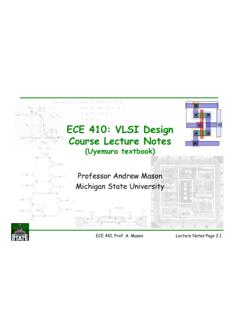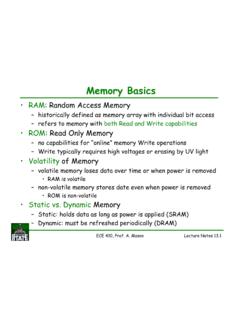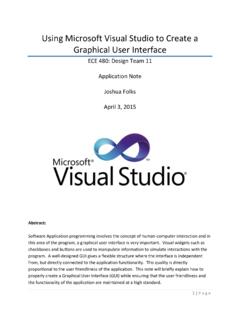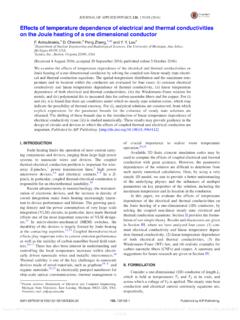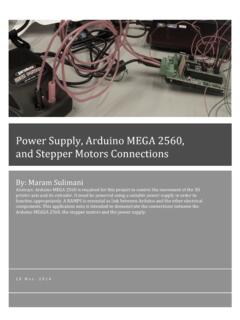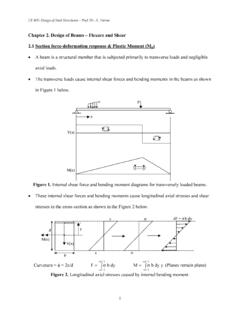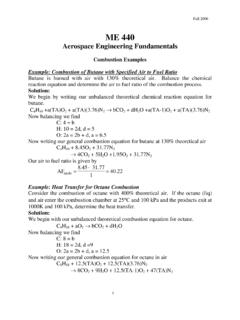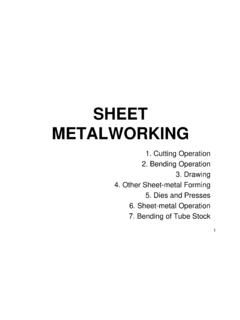Transcription of ECE 410: VLSI Design Course Lecture Notes
1 Lecture Notes Page 410, Prof. F. SalemECE 410: vlsi DesignCourse Lecture Notes (Uyemura textbook)Professor Fathi SalemMichigan State UniversityWe will be updating the Notes this Notes Page 410, Prof. F. SalemElectronics Revolution Age of electronics microcontrollers, DSPs, and other vlsi chips are everywhere Electronics of today and tomorrow higher performance (speed) circuits low power circuits for portable applications more mixed signal emphasis wireless hardware high performance signal processing Sensors, actuators, and microsystems(Digital Camera), Camcorder, PDAsMP3/CD Player Laptop Cell phoneGames: Nintendo; xbox, etc. Lecture Notes Page 410, Prof. F. SalemFigure (p. 2)The vlsi Design Notes Page 410, Prof. F. SalemFigure ( )General overview of the Design Notes Page 410, Prof. F. SalemVLSI Design Flow vlsi very large scale integration lots of transistors integrated on a single chip Top Down Design digital mainly coded Design ECE 411 Bottom Up Design cell performance Analog/mixed signal ECE 410 vlsi DesignProcedureSystem SpecificationsLogic SynthesisChip FloorplanningChip-level IntegrationManufacturingFinished vlsi ChipSchematic DesignLVS(layout vs.)
2 Schematic)Parasitic ExtractionPost-LayoutSimulationDigital CellLibraryMixed-signalAnalog BlocksDRC( Design rule check)SimulationPhysical DesignProcess ModelsSPICEP rocessCharacterizationProcessDesignProce ss Capabilitiesand RequirementsProcessDesign RulesAbstract High-level ModelVHDL, Verilog HDLTopDownDesignBottomUpDesignFunctional SimulationFunctional/Timing/Performance SpecificationsLecture Notes Page 410, Prof. F. SalemIntegrated Circuit Technologies Why does CMOS dominate--Now? other technologies passive circuits III-V devices Silicon BJT CMOS dominates because: Silicon is cheaper preferred over other materials physicsof CMOS is easierto understand??? CMOS is easier to implement/fabricate CMOS provides lower power-delay product CMOS is lowest power can get moreCMOS transistors/functions in same chip area BUT! CMOS is not the fastest technology!
3 BJT and III-V devices are fasterLecture Notes Page 410, Prof. F. Salem Physical Structure of a MOSFET Device Schematic Symbol for 4-terminal MOSFET Simplified SymbolsMOSFET Physical ViewsourcedrainSubstrate, bulk, well, or back gategatenMOSpMOScritical dimension = feature size Lecture Notes Page 410, Prof. F. SalemCMOS Technology Trends Variations over time # transistors / chip: increasing with time power / transistor: decreasing with time (constant power density) device channel length: decreasing with time power supply voltage: decreasing with timeref: Kuo and Lou, Low-Voltage CMOS vlsi Circuits, Fig. , p. 3transistors /chippower /transistorchannel lengthsupply voltagelow power/transistoris critical for future ICsLecture Notes Page 410, Prof. F. SalemMoore s Law In 1965, Gordon Moore realized there was a striking trend; each new generation of memory chip contained roughly twice as much capacity as its predecessor, and each chip was released within 18-24 monthsof the previous chip.
4 He reasoned, computing power would rise exponentially over relatively brief periods of time. Moore's observation, now known as Moore's Law, described a trend that has continued and is still remarkably 26 yearsthe number of transistors on a chip has increased more than 3,200 times, from 2,300 on the 4004 in 1971 to million on the Pentium II m1 m 45 nm(ref: )Feature Size18013090604030 Feature Size (nm) V VYearPower Supply TendsDigital Core Voltage Projectionsfrom the 2000 ITRS** BillionLecture Notes Page 410, Prof. F. Salem MOSFET Device-- 1950+ to 2020 New elements in nano technologies are emerging. These include: Fin-Transistor Memristor: memory resistor- see IEEE Spectrum Nano-tubes Molecular devices Quantum dots Etc. Electronics Building block(s) Lecture Notes Page 410, Prof. F. SalemVLSI Design Flow vlsi very large scale integration lots of transistors integrated on a single chip Top Down Design digital mainly coded Design ECE 411 Bottom Up Design cell performance Analog/mixed signal ECE 410 vlsi DesignProcedureSystem SpecificationsLogic SynthesisChip FloorplanningChip-level IntegrationManufacturingFinished vlsi ChipSchematic DesignLVS(layout vs.)
5 Schematic)Parasitic ExtractionPost-LayoutSimulationDigital CellLibraryMixed-signalAnalog BlocksDRC( Design rule check)SimulationPhysical DesignProcess ModelsSPICEP rocessCharacterizationProcessDesignProce ss Capabilitiesand RequirementsProcessDesign RulesAbstract High-level ModelVHDL, Verilog HDLTopDownDesignBottomUpDesignFunctional SimulationFunctional/Timing/Performance SpecificationsLecture Notes Page 410, Prof. F. Salem Physical Structure of a MOSFET Device Schematic Symbol for 4-terminal MOSFET Simplified SymbolsMOSFET Physical ViewsourcedrainSubstrate, bulk, well, or back gategatenMOSpMOScritical dimension = feature size Lecture Notes Page 410, Prof. F. SalemWhat is a MOSFET? Digital integrated circuits rely on transistor switches most common device for digital and mixed signal: MOSFET Definitions MOS = Metal Oxide Semiconductor physical layers of the device FET = Field Effect Transistor What field?
6 What does the field do? Are other fields important? CMOS = Complementary MOS use of both nMOS and pMOS to form a circuit with lowest power consumption. Primary Features gate ; gate oxide (insulator) very thin (~10^(-10))-- exaggerated in Fig. source and drain channel bulk/substratePolyOxideEEEEV gateinsulatorsilicon substratedrain- - - - - - - - - - - -channelsourceSemi-conductorNOTE: Poly stands for polysilicon in modern MOSFETsLecture Notes Page 410, Prof. F. SalemFundamental Relations in MOSFET Electric Fields fundamental equation electric field: E = V/d vertical field through gate oxide determines charge induced in channel horizontal field across channel determines source-to-drain current flow Capacitance fundamental equations capacitor charge: Q = CV capacitance: C = A/d charge balance on capacitor, Q+ = Q- charge on gate is balanced by charge in channel what is the source of channel charge?
7 Where does it come from?EEEEV gateinsulatorsilicon substratedrain- - - - - - - - - -- -channelsourceQ+Q+Q-WL TopviewLecture Notes Page 410, Prof. F. SalemCMOS Cross Section View Cross section of a 2 metal, 1 poly CMOS process Layout (top view) of the devices above (partial, simplified)Typical MOSFET Device (nMOS) Lecture Notes Page 410, Prof. F. SalemCMOS Circuit BasicsnMOSgategatedrainsourcesourcedrain pMOS CMOS= complementary MOS uses 2 types of MOSFETs to create logic functions nMOS pMOS CMOS Power Supply typically single power supply VDD, with Ground reference typically uses single power supply VDD ranges from ( ) 1V to 5V Logic levels (voltage-based) all voltages between 0V and VDD Logic 1 = VDD Logic 0 = ground = 0V+-VDDVDD=CMOS logiccircuitCMOS logiccircuitVVDD logic 1voltageslogic 0voltagesundefinedLecture Notes Page 410, Prof.
8 F. SalemTransistor Switching Characteristics nMOS switching behavior on = closed, when Vin > Vtn off = open, when Vin < Vtn pMOS switching behavior on = closed, when Vin < VDD - |Vtp| off = open, when Vin > VDD - |Vtp| Digital Behavior nMOS pMOSpMOSnMOSnMOS Vgs > Vtn = on+Vgs-VingatedrainsourceVin+Vsg-gatesou rcedrainpMOS Vsg > |Vtp| = on Vsg = VDD - VinRule to Remember source is at lowest potential for nMOS highest potential for pMOSVinVDDpMOSnMOSVDD-|Vtp|Vtnonoffoffon Vin Vout (drain)1 Vs=0 device is ON0 ? device is OFFVin Vout (drain)1 ? device is OFF0 Vs=VDD=1 device is ONVoutVoutLecture Notes Page 410, Prof. F. SalemMOSFET Pass CharacteristicsnMOSpMOSRule to Remember source is at lowest potential (nMOS) and highest potential (pMOS)+Vgs=Vtn-0 VVDDVDDVDDVy = 0 VVy =VDD-Vtn-Vsg=|Vtp|+VDD0 V0 V0 VVy = VDDVy = |Vtp|on when gate is low on when gate is high Passes a good lowMax high is VDD-VtnPasses a good highMin low is |Vtp| Each type of transistor is better at passing (to output) one digital voltage than the other nMOS passes a good low (0) but not a good high (1) pMOS passes a good high (1) but not a good low (0) Lecture Notes Page 410, Prof.
9 F. SalemMOSFET Terminal Voltages How do you determine one terminal voltage if other 2 are known? nMOS case 1) if Vg > Vi + Vtn, then Vo = Vi (Vg-Vi > Vtn) here Vi is the source so the nMOS will pass Vi to Vo case 2) if Vg < Vi + Vtn, then Vo = Vg-Vtn (Vg-Vi < Vtn) here Vo is the source so the nMOS output is limited Example (Vtn= ): Vg=5V, Vi=2V Vo = 2 VVg=2V, Vi=2V Vo = pMOS case 1) if Vg < Vi - |Vtp|, then Vo = Vi (Vi-Vg >|Vtp|) here Vi is the source so the pMOS will pass Vi to Vo case 2) if Vg > Vi - |Vtp|, then Vo = Vg+|Vtp| (Vi-Vg < |Vtp|) here Vo is the source so the pMOS output is limited Example (Vtp= ): Vg=2V, Vi=5V Vo = 5 VVg=2V, Vi=2V Vo = nMOS,max(Vo) = Vg-VtnFor pMOS,min(Vo) = Vg+|Vtp| Lecture Notes Page 410, Prof. F. SalemSwitch-Level Boolean Logic Logic gates are created by using sets of controlled switches Characteristics of an assert-highswitch y = x A, y = x iff A = 1(iff=if and only if)Series switches AND functionParallel switches OR functionnMOSacts like anassert-highswitch=?
10 Lecture Notes Page 410, Prof. F. SalemSwitch-Level Boolean Logic Characteristics of an assert-lowswitch y = x A, y = x if A = 0 Series assert-low switches ?NORR emember This??DeMorgan relationsa b = a + b, a + b = a ba=1 SW1 closed, SW2 open y=0 = aa=0 SW1 open, SW2 closed y=1 = aNOT function, combining assert-high and assert-low switchesy=xy=?pMOSacts like anassert-lowswitchaberror in figure Notes Page 410, Prof. F. SalemCMOS Push-Pull Logic CMOS Push-Pull Networks pMOS on when input is low pushes output high nMOS on when input is high pulls output lowpMOSnMOS- only one logic network (p or n) is required to produce (1/2-) the logic function???- but the complementary set allows the load to be turned off for zero staticpower dissipationpMOSnMOSassert-lowlogicinputs outputassert-highlogicVSS = groundLecture Notes Page 410, Prof.
